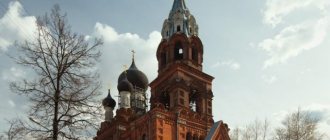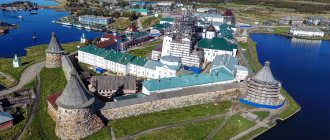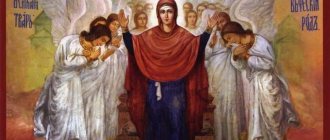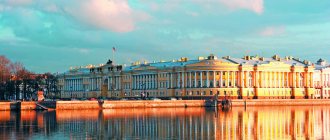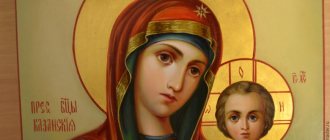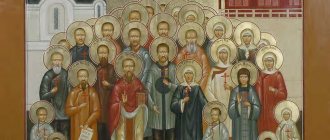*On the cover of the article is a painting by Semyon Rubtsov “Alexander Nevsky on Lake Pleshcheyevo”
Alexander Nevsky is one of the key figures in Russian history, a great commander, legendary politician, saint, canonized by the church, heavenly patron and defender of Rus'. never lost a single battle in his life
and often prevailed in battles with a stronger opponent.
It is safe to say that he has become one of the cultural symbols of our country
, personifying both
the strategic mind of the commander
and
personal courage and dedication.
But what do we know and what don’t we know about a hero who never lost a single battle in his life?
The life and exploits of Prince Alexander Nevsky
Origin of Alexander Nevsky
The exact date of birth of Alexander Nevsky has not been established. It is generally accepted that he was born on May 13, 1221 in Pereslavl-Zalessky. He was the second son in the family, his older brother was Fedor.
Alexander Nevsky is a direct descendant of the first Russian princes Rurik
, both on the paternal and maternal lines. His father is Yaroslav Vsevolodovich (Prince of Novgorod, Pereyaslavl-Zalessky, Grand Duke of Vladimir). The paternal grandfather is Vsevolod the Big Nest, who, in turn, was the son of Yuri Dolgoruky, and he was the son of Vladimir Monomakh. The grandfather of Yuri Dolgoruky is Yaroslav the Wise, who was the son of Vladimir, who was the son of Svyatoslav, and who was the son of Igor...
Mother is the Toropets princess Rostislava Mstislavovna, whose paternal ancestors are also direct descendants of Vladimir Monomakh.
Monument to Alexander Nevsky in Pereslavl-Zalessky
Childhood and youth of the future commander Alexander Nevsky
According to one theory, the boy received his name in honor of the Great Martyr Alexander
- and indeed, at that time in Rus', children were most often given names according to the calendar (a calendar indicating the names of celebrated saints on a certain date); it was believed that in this way the baby acquired a heavenly patron.
According to another version, the newborn prince received his name in honor of Alexander the Great.
This theory is also not without foundation, since some stories related to the personality of Alexander the Great were surprisingly widespread in Rus'.
For example, the artistic image of “the Ascension of Alexander the Great”
, which is often found both in folk paintings and bas-reliefs of early churches - for example, St. Demetrius Cathedral in Vladimir. It is also possible that both versions are correct, and the prince’s parents, choosing a name from those available according to the calendar, settled on something that at the same time reminded them of the great commander of antiquity.
The Ascension of Alexander the Great on the bas-relief of St. Demetrius Cathedral in Vladimir
The great commander’s childhood occurred during a time of protracted and bloody wars, so the children grew up very quickly. Already at the age of 3, Alexander underwent the rite of princely tonsure
(i.e. initiation into warriors).
Thanks to this ritual, the young prince began to be considered equal to adult men, that is, a full participant in military affairs. It is important to note that until the end of the Middle Ages, the social institution of childhood and even the very concept of “child” in the modern sense did not exist. Children were perceived as “little adults,” and children’s perception of the world was considered more likely to be temporary stupidity, rather than a stage in the formation of personality. Very young children were treated rather leniently, but after initiation into warriors - when the boy was put on a horse and given a weapon in his hands - the attitude changed sharply and radically. It was believed that after the ritual, the young warrior was ready to make independent decisions and defend Russia from enemies
. However, at a young age, Alexander was still not exposed to more danger than regular training with a mentor.
P.Anidalov. Presentation of the sword to the young prince Alexander
twelve children in the family of Yaroslav Vsevolodovich
, nine of whom are boys. War games, hunting, and archery training were organized for them. Physical exercises developed the body, and prayers strengthened the soul.
When Alexander was only 8 years old,
and his brother Fedor was 10, their father sent them
to reign in Veliky Novgorod
(at that time - the second most important in Russia after Kiev). Managing a large settlement was difficult for the young princes. Most of the work was carried out by the boyars. However, tough upbringing from an early age bore fruit - Alexander quickly mastered physical training and basic sciences.
Alexander's main mentor is the boyar Fyodor Danilovich. It is he who helps the boy master literacy, history, and etiquette. To study the legal system, the prince regularly attends courts - listens to people's complaints and helps resolve conflicts. The main emphasis in the education of the young man was on military tactics, rules of battle and equestrian art.
O. S. Maslov . God is not in power, but in truth. Alexander Nevskiy
Three years later, when Fyodor dies, eleven-year-old Alexander already has an idea of how to manage people. However, until 1236, his father assisted him in matters of power. After Yaroslav's departure to Kiev, passing the milestone of fifteen years, Alexander becomes the full-fledged and only ruler of Novgorod
.
Before leaving, Yaroslav Vsevolodovich gathers the veche and hands his son a sword - the symbol of the governor - with the words:
“The cross will be your guardian and helper, and the sword your thunder. God gave you eldership among brothers, Novgorod the Great is the oldest reign in all the Russian land.”
Modern view of Veliky Novgorod
Marriage, wife, children, personal life of Alexander Nevsky.
The prince married for the first time at the age of 19. He married the daughter of the Polotsk prince Alexandra Bryachislavovna
(aka Paraskeva).
Her father, Bryachislav Vasilkovich, was the Vitebsk prince, the last of the Rurik dynasty. This union was built
not on profit, but
on the personal feelings of young people
, which at that time was a fairly common practice among the princes, in contrast to subsequent times, when marriages began to be concluded mainly for political reasons. However, after his marriage, Alexander also became responsible for the protection of the Polotsk lands, which were passed to him from his wife.
It is interesting that Alexandra Bryachislavovna was an extremely educated woman
- in the Principality of Polotsk it was not customary to educate princesses in a spirit of reclusion; on the contrary, they were given a broad education, and, for example, the wife of Bryachislav himself replaced him during his absence in the city, being his first assistant and confidant.
Marriage of Alexander Nevsky with the Polotsk princess
Some historians believe that after some time Alexander remarried Princess Vassa
.
However, it is almost impossible to find any information about Vassa; moreover, there is a version that her “appearance” in the prince’s biography is completely a mistake
: perhaps Vasilisa Dmitrievna (Princess of Rostov) is the daughter-in-law of Princess Alexandra (that is, the wife of the third son of Alexandra and Alexander - Andrei Aleksandrovich Gorodetsky), both were buried in the same Dormition Princess Monastery in Vladimir, and after another war or raid they both ended up under the same gravestone... The historian Karamzin was the first to call Vassa the second wife of the prince.
In total the prince had five children,
four of whom are boys. Whether their mother is Alexandra or Vassa is not known for certain, but most sources still connect them with Alexandra, which makes the version of Vassa’s existence even less tenable in principle.
Wishing for the Kingdom of Heaven
Saint Alexander Nevsky, in schema. XVII century Ancient repository of the Holy Trinity Alexander Nevsky Lavra Throughout the anniversary year, many materials dedicated to the holy noble prince Alexander Nevsky were published. An even greater number of scientific works, popular science and artistic publications were published on the topic of his life earlier. They mainly concerned the political activity1 of the holy prince, the significance of his civilizational choice2, his military talent3, his personal piety4, etc. At the same time, there remains a moment in the life of Prince Alexander that requires proper comprehension - this is his Christian death. The Journal of the Moscow Patriarchate published an article by priest Georgy Kharin, associate professor of the Department of Theology at Moscow State Pedagogical University, dedicated to the history of the last days of the blessed Prince Alexander Nevsky (No. 12, 2021).
Immense desire to take on the angelic form
So, in 1262, Grand Duke Alexander Yaroslavich went to Khan Berke.
In the same year, Prince Alexander went to the Tatars, and Berke kept him, not letting him into Rus'; and spent the winter in the Tatars, and fell ill.
This is what the author of the first Novgorod chronicle writes. Historians explain in different ways the reasons that forced the Russian prince to go to the Horde khan. It is often believed that Alexander wanted to prevent the punishment that was expected after the uprising in Russian cities. But the sources at our disposal, and above all the Life of Prince Alexander, explain the reasons for this dramatic trip differently:
Then there was great violence from foreigners: they drove away Christians, ordering them to fight with them. The great prince Alexander went to the king to pray for people from that misfortune5.
Prince Alexander Yaroslavich, it seems, managed this time to “pray” the Russian people from participating in the internal Horde war. Prince Alexander Yaroslavich spent almost the entire year of 1263 - the last in his life - in the Horde, apparently wandering with Khan Berke through his many nomadic camps. And only in the fall - already sick - the prince was finally released back to Rus'. However, Alexander Yaroslavich was not destined to get to the capital Vladimir. From the Novgorod First Chronicle of the older edition:
In summer 6771 (1263). Prince Alexander came from the Tatars in the fall, very unwell. And he came to Gorodets and took monastic vows on the 14th [day] of the month of November, in memory of the holy Apostle Philip. That same night he reposed, and they took him to Vladimir, and laid him in the Monastery of the Nativity of the Holy Mother of God. And, having gathered, the bishops and abbots with Metropolitan Kirill, and with the entire priestly rank, and with the monks, and with all the Suzdal residents, buried him with honor on the 23rd [day] of the same month, on Saint Amphilochius, on Friday. Grant, O merciful Lord, to see Your face in the next century for him, who labored for Novgorod and for the entire Russian land...6
The death of the noble prince is described in more detail in his Life:
In those days there was great violence from non-believers; they persecuted Christians, forcing them to fight on their side. The great prince Alexander went to the king to pray for his people from this misfortune.
And he sent his son Dmitry to the Western countries, and sent all his regiments with him, and his close household members, saying to them: “Serve my son, as you serve me, with all your life.” And Prince Dmitry went in great strength, and conquered the German land, and took the city of Yuryev, and returned to Novgorod with many prisoners and with great booty.
His father, Grand Duke Alexander, returned from the Horde from the Tsar, and reached Nizhny Novgorod, and fell ill there, and, arriving in Gorodets, fell ill. Oh, woe to you, poor man! How can you describe the death of your master! How will your eyes not fall out along with your tears! How can your heart not be torn out by the roots! For a man can leave his father, but he cannot leave a good master; If it were possible, I would go to the grave with him!
Having worked hard for God, he left the earthly kingdom and became a monk, for he had an immeasurable desire to take on the angelic image. God also vouchsafed him to accept a greater rank—schema. And so in peace he gave up his spirit to God in the month of November on the fourteenth day, in memory of the holy Apostle Philip.
Metropolitan Kirill said: “My children, know that the sun of the land of Suzdal has already set!” Priests and deacons, monks, poor and rich and all the people exclaimed: “We are already perishing!”
The holy body of Alexander was carried to the city of Vladimir. The Metropolitan, the princes and boyars and all the people, small and large, met him in Bogolyubovo with candles and censers. People crowded, trying to touch his holy body on his honest bed. There was a cry, a groan, and a cry like never before, even the earth shook. His body was laid in the Church of the Nativity of the Holy Mother of God, in the Great Archimandrite, on the 24th day of November, in memory of Holy Father Amphilochius.
There was a marvelous miracle then, worthy of memory. When his holy body was laid in the tomb, then Sebastian the Economist and Cyril the Metropolitan wanted to unclench his hand in order to insert a spiritual letter. He, as if alive, stretched out his hand and took the letter from the hand of the metropolitan. And confusion seized them, and they retreated slightly from his tomb. Metropolitan and Housekeeper Sevastian announced this to everyone. Who wouldn’t be surprised by that miracle, because his soul left his body and he was brought from distant lands in winter! And so God glorified His saint7.
This is how his ancient Life reports the death of the prince. Here, in fact, is the subject of our research:
The Grand Duke Alexander Yaroslavich, deeply zealous for his Lord God, leaving the earthly kingdom and desiring the Heavenly Kingdom, accepted the angelic image of monastic life; God also vouchsafed him a greater rank of reception—schema...
I'll cut my hair when I'm old too
Accepting monasticism is a serious and responsible step. What prompted the Grand Duke to make this decision? To understand this is to feel his era. By the way, in other times such a choice would hardly have been encouraged: Peter I even prohibited by his decree, duplicated by the synodal decree of June 15, 1724, the depiction of Alexander Nevsky in the monastic rank:
The Holy Blessed Grand Duke Alexander Nevsky in a monastic person should not be depicted by anyone, but only in the robes of a grand duke8.
Obviously, this was caused by the desire of Peter I to contrast the new capital, St. Petersburg, with the old one, Moscow. The main shrine of Moscow has always remained the Lavra of St. Sergius with the Radonezh miracle worker himself. Firstly, the image of St. Sergius, with his deep piety and zeal for salvation on the spiritual path, was completely at odds with Peter’s ideas of universal utility, borrowed from Dutch thinkers. Secondly, the Monk's Lavra reminded Peter of his rebellious youth and his shameful flight under its walls. That’s why there was such a need for a “secular Lavra” with a “secular” saint—a non-monastic way of life and a non-ecclesiastical feat. This explains the founding of the Alexander Nevsky Lavra and the transfer of the relics of the holy prince here from Vladimir, as well as the ban on his depiction in monastic robes.
Let's return to the issue of Alexander Nevsky's monastic tonsure. What caused it? A tribute to tradition or a need of the soul? Let's start with the fact that, indeed, deathbed tonsure is a tradition that was very widespread in Rus' at that time. This custom was borrowed from the Byzantine aristocracy. At least 17 Byzantine emperors took monastic vows on the eve of their death or after their dethronement (in the latter case, often against their own will: Andronikos II Palaiologos, John VI Cantacuzenus, Isaac I Komnenos, Zoe, who cut her hair and later cut it again, and her sister, who cut her hair Theodora, Michael VII Ducas, Michael I Rangave, Romanus I Lecapinus, Theodosius III and others).
It is known that before his death, Emperor Michael IV of Paphlagon (1041), Manuel I Komnenos - under the name Matthew (1180), John VII Palaiologos - Joasaph (1408), Manuel II Palaiologos - Matthew (1425) took monastic vows. Among the women before her death, as is known, Empress Irene (wife of John II Komnenos) - Xenia (1134), daughter-in-law of the emperor Anna Dalassina9 - cut her hair.
There is a sufficient amount of research on the development of the institution of monasticism in Rus'. Among them, it is especially worth noting the collective work of B.A. Uspensky and F.B. Uspensky “Monastic names in Rus'”10. Here the question of interest to us is considered in detail. Indeed, from early times in Rus' there was a custom of accepting the great schema in anticipation of imminent death. This tradition existed in the monasteries, and it becomes the subject of discussion in the Question of Kirik. Kirik the Novgorodian asked Nifont, Archbishop of Novgorod (1130-1156), whether it would be good for him to accept the great schema in his old age; Nifont answered in the affirmative:
And here’s what I told the bishop: I’m still without a schema, but when I’m old I’ll also take monastic vows, maybe then I’ll become better, but I’m bad and sick11.
Kirik also asked Nifont if he, Kirik, without being a schema monk, could tonsure a person who is in danger of imminent death into the schema:
But again, a certain monk repented from me, will it be possible to tonsure him into the schema soon? Or is it not appropriate to tonsure yourself without a schema? If you command me, it would be very good. He said: “You have thought well that, as you said, in your old age you will take monastic vows into the schema. And for tonsuring monks, that’s why you are a priest, and tonsure him into the schema. The priesthood is above all else, and that is why sanctification exists.” And I bowed to the lord with my forehead12.
And this time Niphon answered in the affirmative, citing the fact that Kirik is a priest and thus has the right to do so.
God gave you a gift
The Kiev-Pechersk Patericon tells about Pimen the Long-Suffering, whom his parents brought to the Pechersk Monastery for healing; he wanted to take monastic vows, but his parents did not agree to this. Unexpectedly, he is tonsured into the great schema, and he receives a new name. This is described as a miracle:
When he became so exhausted that they despaired for his life, they brought him to the Pechersk Monastery so that he could be healed by the prayers of those holy fathers or at their hands he would receive the holy monastic image. Pimen’s parents, loving him deeply, did not abandon their child and asked everyone to pray for their son so that he would be healed of his illness. And those reverend fathers worked a lot, but nothing brought him any benefit, for his prayer prevailed over all others, and he asked for himself not for health, but for an increase in illness, because he was afraid that if he recovered, his parents would take him away from the monastery, and not his dream will come true. His father and mother were with him all the time and did not allow him to cut his hair, and the blessed one, saddened, began to diligently pray to God to fulfill his desire.
And then one night, when everyone around was sleeping, they entered with candles where Pimen lay, looking like bright eunuchs, and they carried the Gospel, and a shirt, and a mantle, and a doll, and everything that was required for tonsure, and they said to him: “Do you want us to cut your hair?” He joyfully agreed, saying: “The Lord has sent you, my lords, to fulfill the desire of my heart.” And immediately they began to ask: “Why did you come, brother, falling to this holy altar and to this holy brotherhood? Do you want to be honored with the monastic great angelic image?” And they did everything else according to the order, as written in the charter, then they tonsured him into the great image, and put on him a mantle and a doll, and everything that follows, having sung the funeral service, they honored him with the great angelic image, and, kissing him, gave him the name Pimen , and, having lit a candle, they said: “For forty days and nights this candle will not go out.” Having completed all this, they went to church, and took the hair of the man who had been tonsured with them in a scarf and laid it on the tomb of Saint Theodosius13.
The monks who were in the cells, hearing the sounds of singing, awakened those sleeping around, thinking that the abbot was tonsuring Pimen with someone or that he had already died, and they all entered together into the cell where the sick man lay, and found everyone sleeping: both the father and the father. both mother and slaves. And together with them they approached the blessed one, and everyone felt the fragrance, and saw him cheerful and joyful and dressed in monastic clothes. And they asked him: “Who tonsured you and what kind of singing did we hear? Your parents were with you and didn’t hear any of this.” And the sick man said to them: “I think it was the abbot who came with the brethren, tonsured me and gave me the name Pimen. Their singing was what you heard, and about the candle they said that it would burn for forty days and nights; taking my hair, they went to church.” Having heard this from him, they went and saw that the church was closed, and woke up the sextons, and asked them if anyone had entered the church after evening prayer? They answered, saying that no one had entered it and that the housekeeper had the keys. Taking the keys, they went to the church and saw Pimen’s hair in a scarf on Theodosius’s coffin, and told the abbot about everything, and began to look for who tonsured Pimen, and did not find it. And everyone understood that it was Providence from above, from God. And they began to think about the former miracle, saying: “Can it count towards Pimen’s statutory tonsure?” But since there was evidence: the church was locked, and the hair was on the tomb of St. Theodosius, and the candle, which would have only lasted for a day, forty days and nights burned incessantly and did not burn out, they did not begin to tonsure Pimen, telling him: “The gift given to you and the name given to you from God is sufficient for you, brother Pimen.”14
This passage from the Patericon is very important: it allows you to roughly imagine how the tonsure of Grand Duke Alexander took place on his deathbed. It is also interesting that this story of the Patericon ends with a very useful lesson:
From this, brothers, it seems to me that this should be understood: if someone in illness takes tonsure with faith, asking God for life, he will serve him as in a monastic feat; The Lord, who rules life and death, even if he takes him away from the world, then, like workers hired at the eleventh hour, he will recognize him as equal to the righteous. Whoever says this: “When you see me dying, then tonsure me,” his faith and tonsure are vanity15.
Find the main thing
Many examples from the hagiographic literature of the Old Russian period indicate that the monks of Ancient Rus' sought to accept the schema before their death. Over time, the laity also begin to accept the great schema - initially, perhaps, imitating the monks.
From the second half of the 12th century, tonsure before death into the great schema became widespread among the princes16; later, the kings continued to do the same, right up to the Romanovs (the latter, apparently, did not have such a family tradition). If death came prematurely, then sometimes - in exceptional cases - tonsure was given after death, as happened with Ivan the Terrible and as, apparently, could have happened with Vasily III; this indicates the sustainability of this custom17.
In Ancient Rus' we even know of a case of collective death tonsure. In 1238, when the Tatars captured Vladimir-on-Klyazma, Prince Vsevolod Yuryevich with his mother, his people and Vladyka Mitrofan entered the Holy Mother of God and shaded everything in the image of the Chernech and in the sky18.
The Great Schema thus symbolizes readiness for death.
The custom of dying tonsure is associated with the idea that monastic tonsure, like baptism, cleanses a person from all previous sins. This motive is reflected in the “Tale of the Massacre of Mamayev”: with the blessing of St. Sergius of Radonezh, the monastic brothers Alexander Peresvet and Andrei Oslabya, going to mortal combat, accept the schema19. Thus, tonsure into the schema began to be treated as a sacrament.
This attitude towards monastic tonsure is associated with the special influence of St. Simeon the New Theologian on the Old Russian Church. The era of Simeon the New Theologian, the 10th century, is the era of the monastic renaissance. The Monk Simeon, without hesitation, calls his monks, including those without rank, “the people of Christ, the sacred flock, the royal priesthood”20. Apparently, this is why in Rus', which was adopting Christianity at this very time, the view of monasticism as the only true path to salvation became very widespread. In his letter to Polycarp, Bishop Simon, for example, states:
I would be glad to leave my bishopric... Before God I say to you: I would have crushed all this glory and power like feces, if only I had been thrown into the gates with cod, or dared to wallow in the Pecherky monastery and be trampled underfoot by being a man...21
In ancient Russian hagiographic literature one can find many examples illustrating the idea of the special significance of monasticism22. Apparently, this circumstance explains both the enormous influence that monasteries had on ancient Russian society, and the reverence that this society had for monasticism in general and for tonsure in particular.
Therefore, by taking monastic tonsure just before his death, the holy noble prince Alexander, on the one hand, followed the pious custom of his time, and on the other hand, through this tonsure he sought to gain the main thing that made up the whole meaning of his earthly path - eternal life in Christ Jesus our Lord.
Victories of Alexander Nevsky - what victories did Alexander Nevsky win?
Alexander won the Battle of the Neva,
when he was not yet 20 years old.
The victory on Lake Peipsi (Battle of the Ice)
was won by the prince at the age of 22. These battles are among the most famous both in the history of Russia and in the life of our great commander. However, besides them, he won many other victories.
Yuri Pantyukhin. Alexander Nevskiy
Lithuania
- a constant enemy of Ancient Rus' - regularly raided Russian lands.
In 1245, Prince Alexander and his retinue liberated Torzhok, Toropets, Bezhetsk, previously captured by the Lithuanians
.
Without the help of the residents of Novgorod and Vladimir, only with the forces of his squad, he defeats the remnants of the Lithuanian army and pursues him for so long and fiercely that the Lithuanian soldiers no longer made a single raid on Russia
; chroniclers wrote on this subject that they began
to “observe his name "
(that is, to be afraid, to be careful). The last battle, which resulted in the destruction of the remnants of the Lithuanian army, took place near Usvyat. These victories significantly strengthened the northern borders of Rus'.
14 years after the Battle of the Ice, the Pope decided to repeat the attempt to convert Russia to Catholicism
.
The Swedish warriors planned to build a fortress on the border of the state, and only after that - to launch an offensive. Alexander, having sensibly assessed the enemy’s strength, began preparations. By that time, the fame of the prince’s exploits and his lack of defeats was so great that the Swedes, noticing the beginning of preparations for the Russian army, retreated.
So Nevsky won without a fight .
Semyon Rubtsov. Alexander Nevsky on Lake Pleshcheyevo
Legend 9. There was no battle on the ice at all
Verdict: This is not true.
At first we made a mistake and wrote “Battle of the Neva” in the title instead of “Battle on the Ice”. Now everything is correct!
Battle on the Ice. Miniature from the Facial Chronicle. 16th century Russian National Library
The battle is written both in Russian chronicles and in the German “Livonian Rhymed Chronicle” of the 13th century. Of course, the nameless German author praised the exploits of the “God’s knights” of the Livonian Order and downplayed their defeat, and yet he did not deny the fact that there was a battle and the Russians won. Another thing is that this was not an epoch-making battle that changed the fate of countries and peoples, although more than a thousand and perhaps even several thousand people took part in it.
On the Russian-Livonian border, armed clashes and large campaigns between neighbors against each other were commonplace. The troops of the Livonian Order besieged Pskov more than once, and the Russian princes, in turn, led squads deep into German possessions. For example, Svyatoslav and Mikhail Yaroslavich together with the Pereyaslav army, that is, troops. under the leadership of Dmitry Alexandrovich, the son of the prince, they defeated the combined army of the Danes and the Livonian Order.
Alexander Nevsky and the Horde
Based on the relationship between Alexander Nevsky and the Crusaders and Lithuanians, we can speak with complete confidence about his uncompromising attitude towards external invaders. However, in the case of the Horde, we see a completely different picture - Alexander emphatically did not conflict with the Horde, he went there several times, in particular, he stayed with Batu Khan in Karakorum for more than 2 years
(1247–1249), there is even
evidence of Alexander’s friendly relations with Khan Batu and twinning with his son
:
“...(in 1251) Alexander came to Batu’s horde
, became friends, and then
fraternized with his son Sartak, as a result of which he became the son of the khan
and in 1252 brought the Tatar corps to Russia with the experienced noyon Nevryuy” (L. Gumilyov)
F. Moskvitin. Alexander Nevsky and Sartak in the Horde.
Some historians blamed such “warm” relations with the khans on Alexander, using them as evidence of “the ambiguity of Alexander’s personality in the history of Russia,” others, the same Lev Gumilyov, wrote about this aspect of Nevsky’s biography as evidence of his greatest foresight and talent as a politician.
Alexander's actions are interpreted as
a desire to establish peaceful relations with a dangerous and strong neighbor
, avoiding bloodshed and the risk of complete defeat - since it was obviously impossible to win.
All this is quite surprising in the context of other events in Alexander’s life
. Why not then establish friendly, peaceful relations with the Livonian Order, with Lithuania, and with the Pope? After all, none of the won battles was easy and there was always a risk of suffering a crushing defeat... The very context of his first trip to Karakorum is also unusual - so in 1246 his father Yaroslav Vsevolodovich went to the Horde, who, presumably, was poisoned there. And now - Alexander himself is already going to the khan (and not at his own request - but at the will of the khan), where he stays for almost two years and behaves so politely, despite all the rumors about his father’s poisoning, that then the khan sends him back and transfers to him the ownership of “the entire Russian land.”
Pavel Ryzhenko. Fragment of the triptych “The Sun of the Russian Land”. Sartak.
An alternative view of the history of Rus' (in the context of the relationship between Alexander Nevsky and the Horde)
All these oddities can be explained in the best possible way if we abandon the theory of the Tatar-Mongol yoke in the “usual format” altogether. In fact, the biography of Alexander Nevsky itself and this “problem” with the Horde
are
one of the best proofs of the absence of a mythical “yoke”
in our history.
So where and why did Alexander Nevsky go for 2 whole years (and then more than once)? Suffice it to remember that initially the word “horde” in Russia meant “army”
and compare the titles of the characters (prince and great khan/kam).
The conclusion suggests itself that Alexander’s visits to the Horde should be considered NOT as trips of a far-sighted politician to a stronger foreign policy player, but as trips of a general-commander to the headquarters of his own high command
.
Moreover, the Horde
, according to this version,
is NOT at all hostile to Russia
(which we see from Alexander’s own relations with the khan, from how during the “yoke” at least only architecture flourished in Russia, how peacefully the Horde treated the religion and culture of the conquered, from evidence of numerous marriages between the nobility of the Horde and Russia, etc., etc.).
This is just an army of a great Empire the size of a continent,
which performs, among other things, regulatory and punitive functions - that is,
it fights the processes of disintegration, fragmentation, attempts to break off border pieces from the Power
(Alexander also fought with exactly the same thing on the borders of the north -Western Russia, that is, on the “front line”, where these problems were especially acute).
This is precisely what explains the fact that some Russian cities the “Horde” passed by without touching them and calmly left them in their rear, while others were ruined to the ground, while “raids” were carried out rather irregularly, sometimes not appearing on Russian soil for years. So, maybe they are the same us, as they say in the descriptions of the appearance of the khans and pictures of battles left by contemporaries, where it is impossible to identify who are “Russians” and who are “Horde”...
Pictures of battles between Russian regiments and Tatar-Mongol regiments
from chronicles and frescoes.
A detailed analysis of the myths about the Tatar-Mongol yoke and some assumptions about what it actually was can be read here. We will return to Alexander, whose services to the Russian land are undeniable - no matter what version of the essence of the Horde we adhere to.
Alexander Nevsky - interesting facts
- Alexander Nevsky bore the titles Prince of Novgorod, Grand Duke of Kiev
(from 1249),
Grand Duke of Vladimir
(from 1252); - Alexander’s grandfather is the famous Vsevolod the Big Nest;
- Nevsky's youngest son, Daniil, became the first appanage prince of Moscow;
- the prince conducted personal correspondence with Pope Innocent IV.
The latter escaped Alexander to convert the Russian people to Catholicism and use the crusading knights to suppress the Horde. However, Nevsky refused; - Reliable information about Alexander’s appearance
has not been preserved. The most common belief is that the prince was short (up to 170 cm), but wiry and strong. However, it is a scientifically proven fact that in the past people were, in principle, shorter, so with a height of 170 he could be considered a “very tall” person; - There is a theory that Alexander received the nickname “Nevsky”
not because of the battle, but because he owned lands along the banks of the Neva. As evidence, the fact is cited that the nickname Nevsky also applies to his sons, who did not participate in the legendary battle for a few years. However, it is difficult to call this significant evidence - after all, they could well have “inherited” their father’s title; - In the fall of 1263, Prince Alexander Yaroslavich returned from another trip to the Horde in poor condition. Feeling the approach of death, he took monastic vows under the name Alexy. He died on November 14 at the age of 42 in Gorodets.
The body was transported to Vladimir and buried in the Cathedral of the Nativity of the Virgin Mary of the Vladimir Nativity Monastery; - Alexander's canonization
as a saint did not occur until the 16th century (that is, approximately 300 years later), although veneration began immediately after his death.
Bust of Alexander Nevsky in front of the Rosconcert building
Legend 1. Nevsky began to rule when he was very young
Verdict: This is partly true.
Alexander Yaroslavich on the throne. Miniature from the Facial Chronicle. XVI century Russian National Library
For princes and other noble people in Russia, adult life began very early. When Alexander was seven years old, he, together with his older brother Fedor, became the deputy of his father, Prince Yaroslav Vsevolodovich, in Novgorod. True, the affairs were then handled by the boyar Fyodor Danilovich and the tiun, who were left with the children. Tiuns in the 11th–13th centuries were the name given to the privileged princely and boyar servants who managed the household. Yakim. Alexander began to truly rule at the age of 26, after the death of his father.
Sword of Alexander Nevsky
endowed in legend with certain mystical properties , has always been of particular interest to contemporaries and descendants.
, because Alexander did not lose a single battle in his life.
Accurate data on its appearance, weight and characteristics have not been preserved, but for comparison we can say that the average sword of that era weighed about 1.5 kg.
The legend says that
during the Battle of the Neva
, attacking the enemy, the prince raised his sword over him and everyone saw that
light was emanating from the weapon
. It can be assumed that Alexander and his army were facing the sun, so that the light was a reflection of the sun's ray. Nevertheless, the prince’s victorious weapon acquired legendary status, and was placed after the battle in the house of elder Pelgusius (the same one who first noticed enemy ships off the banks of the Neva).
Konstantin Vasiliev. Russian knight
After the fire in the building, the sword could not be restored. However, later, in the 18th century, during excavations, the monks found fragments of this sword. When the building was rebuilt, the remains of the weapons were buried under the foundation. It was believed that the sword was supposed to protect the church being built from disasters. It is noteworthy that nothing has really happened to the construction since then.
During the October Revolution, the documents of the temple were completely burned, but a small manuscript by Andrei Ratnikov, a white officer,
.
In the document, he described the sword of Alexander Nevsky itself, and the prediction that Russia would be indestructible as long as the prince’s sword was kept in his native land
.
Gorbunov Konstantin. Alexander Nevskiy
Alexander Nevsky - Holy Blessed Grand Duke
Church veneration of the great warrior and ruler began immediately after his death. There is a legend about a miracle
which happened during his burial: when Metropolitan Kirill wanted to place a spiritual letter in the hand of the deceased, he extended his hand as if alive and took it on his own.
Officially a church
highly appreciating the prince’s merits in preserving Orthodoxy in Russia,
canonized Alexander in 1547 as the Holy Blessed Prince
, who during the years of his reign was guided by the highest Christian virtues, and not by self-interest or thirst for power.
A sculptural image of the holy noble prince Alexander Nevsky on the facade of the main Temple of the Armed Forces of the Russian Federation in Patriot Park
In 1721 Peter I
decided to consecrate the day of concluding peace with the Swedes
by transferring the relics of the commander from Vladimir (where he was buried) to the new Northern capital - St. Petersburg
. On August 30, 1724, the relics were installed in the Trinity Cathedral of the Alexander Nevsky Lavra. In 1922, the sarcophagus with the relics was opened and divided - so, the relics were sent to the State Museum of the History of Religion and Atheism (on the territory of the Kazan Cathedral), and the silver shrine was sent to the Hermitage. Currently, the relic remains in the Hermitage; the relics themselves were returned to the Trinity Cathedral in 1989.
Prince's Memorial Day - December 6
(or September 12, old style),
Legend 7. Nevsky did not lose a single battle
Verdict: It's true.
Lubok "The Holy Blessed and Grand Duke Alexander Nevsky." First half of the 18th century Russian National Library
The prince was raised from an early age as a future warrior: as a child he began to accompany his father on campaigns. In 1235, fourteen-year-old Alexander took part in the Battle of the Emajõgi River (in modern Estonia), where the troops of Yaroslav Vsevolodovich defeated the Germans.
In addition to the well-known victories in the Battle of the Neva and the Battle of the Ice, the prince successfully repelled the raids of the Lithuanian leaders, and in 1256 he made a great campaign to Finland: “When he came to the land of Em, he killed some, and confiscated others; and the Novgorodians arrived with Prince Oleksandr in all health” “I came to the land [of the tribe] to eat, killed some, and took others prisoner; and the Novgorodians came with Prince Alexander, all healthy.” Novgorod first chronicle of the senior edition // Complete collection of Russian chronicles. T. 3. M., L., 1950. .
Prince Alexander Nevsky in the memory of the people
Russian people sacredly honor the services of Prince Alexander Nevsky to the Fatherland. The order named after him was one of the highest awards of the Russian Empire from 1725 to 1917. Peter I intended to establish it as a reward for military exploits. But Catherine I used it to reward civilians. At the beginning of the 20th century, this order was a traditional award for statesmen who devoted more than a dozen years to serving Russia.
Order of Alexander Nevsky USSR
In 1942, the Order of Alexander Nevsky received a rebirth. It was established by the Decree of the Presidium of the Supreme Soviet of the USSR as a reward to Red Army officers for personal courage, bravery and command of a unit that ensured success in the battle. During the Second World War, this order was awarded to more than 40 thousand people. After the collapse of the USSR, the order remained in the award system of the Russian Federation, but until 2010 it did not have status, and therefore was not used for awards. Today it is a national award. Its design corresponds to the pre-revolutionary appearance.
Alexander Nevsky Monastery in St. Petersburg
Streets and squares in many Russian cities are named after the great commander. For example, the seven-span bridge in St. Petersburg, lying across the river. Neva, in addition, Alexander Nevsky is considered the heavenly patron of St. Petersburg.
Alexander Nevsky in art - in literature, painting, cinema, sculpture
The first mention of the prince in literature appeared thanks to a chronicler, his contemporary. Saint Demetrius of Rostov wrote the work “The Life of Alexander Nevsky,” which is one of the priceless monuments of Ancient Rus'.
In 1937 Konstantin Simonov
(author of the novel “The Living and the Dead”) wrote
the poem “Battle on the Ice”
as a premonition of the impending war.
Still from the film “Alexander Nevsky” by S. Eisenstein (1938)
In the period from 1944 to 1948. Alexey Yugov
wrote the popular epic
“Warriors”
, in which Nevsky is shown as the greatest politician and warrior in Russia.
In 1952 Vasily Yan
published the story
“The Youth of a Commander”
.
In 1977, the story “Mr. Veliky Novgorod”
by D. M. Balashov
, telling about the life of the prince.
In 1997 Boris Vasiliev
- author of the works “And the Dawns Here Are Quiet...” and “Not on the Lists”, published
the novel “Alexander Nevsky”
.
Later the book was republished and is now called “Prince Yaroslav and his sons
.
In painting, much attention is paid to the image of Alexander Nevsky, however, there is no reliable lifetime image of the prince, therefore in most modern paintings his appearance is close to the appearance of Nikolai Cherkasov
, who played the main role in the famous film by
S. Eisenstein “Alexander Nevsky” (1938)
. This film was awarded the Stalin Prize and was a resounding success during the Great Patriotic War.
The most famous monuments dedicated to the Grand Duke are:
- sculptural composition on Mount Sokolikha in Pskov;
Monument to Alexander Nevsky in Pskov.
Author: I. I. Kozlovsky
- a monument in St. Petersburg, located opposite the entrance to the Alexander Nevsky Lavra, designed by architect Valentin Kozenyuk;
- a monument erected in Veliky Novgorod on the embankment in 1985; another monument is located in the city center opposite the Church of Boris and Gleb.
Monument to Alexander Nevsky in Veliky Novgorod, opposite the Church of Boris and Gleb
Legend 2. He was cruel and merciless: he cut off noses and gouged out eyes
Verdict: It's true.
The ceremonial entry of Alexander Nevsky into the city of Pskov after his victory over the Germans. Painting by Grigory Ugryumov. 1793–1794 State Russian Museum
In the Middle Ages, human rights were perceived differently than they are now: the lives of ordinary people were not valued at all. Having liberated the captured fortress of Koporye in 1241, the prince took the knights of the Livonian Order Livonian Order is a branch of the Teutonic Knightly Order in Livonia (the territory of modern Latvia and Estonia). captured and brought to Novgorod. Alexander hanged the local residents who submitted to them to discourage them. And during the campaign on the territory of the Dorpat bishopric, the Dorpat bishopric is a spiritual-feudal principality created in the southeastern part of the modern Republic of Estonia. Founded in 1224 by Archbishop Albert of Riga after the Baltic States were invaded by the Order of the Sword, known as the Livonian Order. in 1242, he released his warriors “to prosper” Novgorod first chronicle of the senior edition // Complete collection of Russian chronicles. T. 3. M.; L., 1950., that is, to rob farmers and fishermen living in enemy territory.
This is how his opponents and other princes of that era fought. But when in 1257 his son Vasily, who was then the Prince of Novgorod, did not want to give tribute to the Tatars and fled to Pskov, Alexander really brutally dealt with his servants: “I cut off the nose of one, and took out the eyes of another.” I gouged out my eyes." Ibid.. This was a very severe punishment, but the situation was also dangerous: unrest began in Novgorod. Posadnik Posadnik is the head of the city, appointed by the prince. Mikhalko Stepanovich was killed, and the Lithuanians made a successful raid on the city of Torzhok, a major trading point on the way to Novgorod from the southern regions of Rus'.
